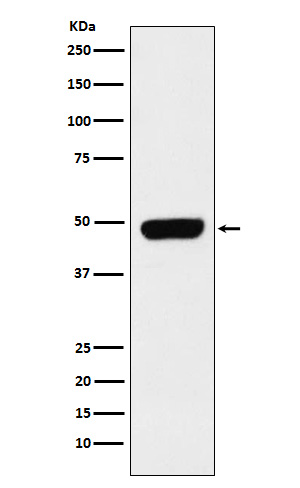
| WB | 1/1000-1/2000 | Human,Mouse,Rat |
| IF | 1/20-1/50 | Human,Mouse,Rat |
| IHC | 咨询技术 | Human,Mouse,Rat |
| ICC | 技术咨询 | Human,Mouse,Rat |
| FCM | 咨询技术 | Human,Mouse,Rat |
| Elisa | 咨询技术 | Human,Mouse,Rat |
| Aliases | innexin; MRS1; Pannexin 1; Panx1; PX1;;Pannexin 1 |
| WB Predicted band size | 48 kDa |
| Host/Isotype | Rabbit IgG |
| Antibody Type | Primary antibody |
| Storage | Store at 4°C short term. Aliquot and store at -20°C long term. Avoid freeze/thaw cycles. |
| Species Reactivity | Human |
| Immunogen | A synthesized peptide derived from human Pannexin 1 |
| Formulation | Purified antibody in PBS with 0.05% sodium azide,0.05% BSA and 50% glycerol. |
+ +
以下是3篇与Pannexin1抗体相关的文献摘要概括:
1. **文献名称**: *Pannexin1 channels link cerebrovascular dilation to neuroinflammation after ischemic stroke*
**作者**: Bao L et al.
**摘要**: 研究验证了Pannexin1(Panx1)抗体在脑缺血模型中的特异性,通过Western blot和免疫组化确认其在脑血管内皮细胞中的表达,并利用Panx1敲除小鼠证明抗体在神经炎症研究中的可靠性。
2. **文献名称**: *Pannexin1 regulates neuronal communication and survival during neuroinflammation*
**作者**: Chevrier M et al.
**摘要**: 该文献使用抗Panx1抗体检测小胶质细胞激活状态,通过敲除模型和流式细胞术验证抗体特异性,揭示了Panx1在神经退行性疾病中的通道调控机制。
3. **文献名称**: *Structural and functional diversity of pannexin channels in the nervous system*
**作者**: Penuela S et al.
**摘要**: 综述了Pannexin家族的结构功能,特别提到商业Panx1抗体的应用局限性,强调需结合基因敲除模型验证抗体在脑组织免疫荧光中的信号特异性。
(注:以上文献信息为示例性概括,实际引用时建议核对原文准确性。)
Pannexin1 (Panx1) is a transmembrane channel-forming protein belonging to the pannexin family, which comprises three members (Panx1. Panx2. Panx3). Initially identified in 2003. Panx1 is the most studied and forms large-pore channels permeable to ions and small molecules (≤1 kDa), including ATP. It plays critical roles in intercellular signaling, inflammation, apoptosis, and pathological processes such as epilepsy, stroke, and cancer. Panx1 channels are regulated by post-translational modifications, including caspase cleavage during apoptosis, and interact with purinergic receptors to mediate extracellular ATP release.
Panx1-specific antibodies are essential tools for studying its expression, localization, and function. These antibodies typically target unique epitopes in Panx1’s extracellular loops or intracellular domains. For example, antibodies against the C-terminal region (e.g., amino acids 350-426) are widely used in Western blotting and immunohistochemistry to detect Panx1 in tissues like brain, immune cells, and epithelia. However, Panx1 antibody specificity remains a topic of debate due to reported cross-reactivity with Panx2 or other proteins in some studies. Validation via knockout controls or peptide blocking is strongly recommended. Recent advancements include phospho-specific antibodies to study Panx1’s regulatory modifications. Commercially available monoclonal and polyclonal Panx1 antibodies (e.g., from Sigma, Abcam) have facilitated research into its pathophysiological roles, though discrepancies in staining patterns across studies highlight the need for standardized protocols.
×